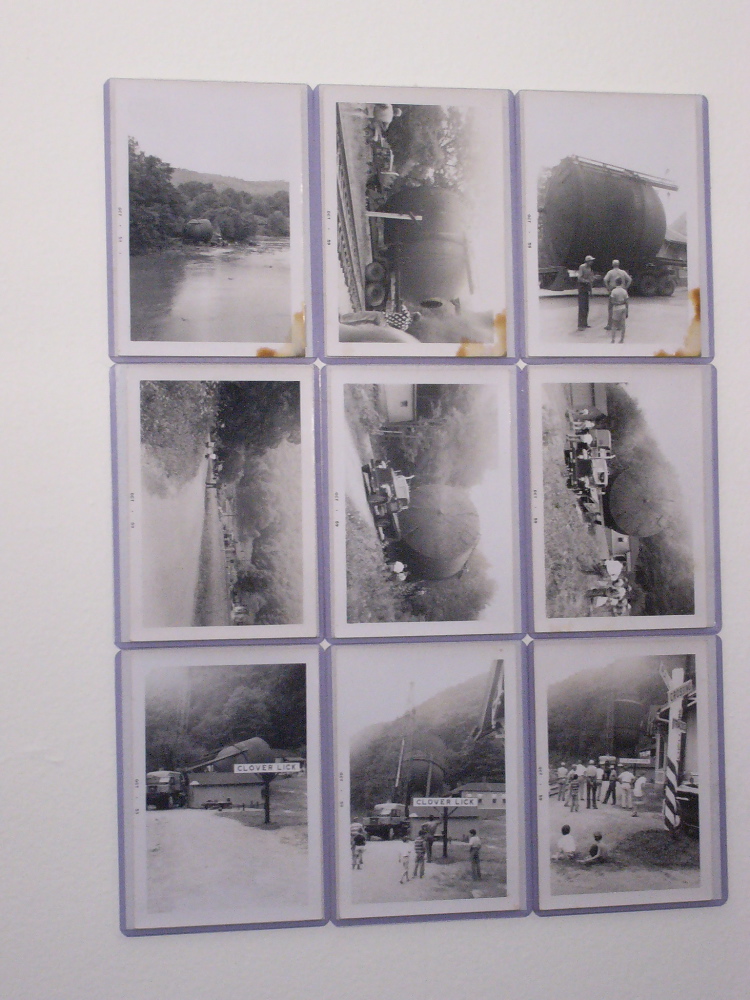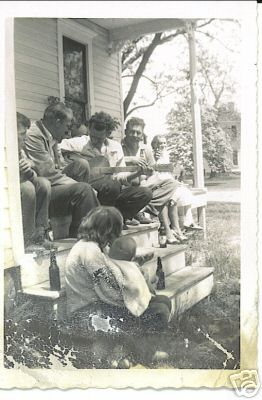Schwarz
View current page
...more recent posts
h.w. (costanza~cantstandya)
untitled (clover lick tank) 11 3/4 x 15 3/4" 10/59-6/05 photographic prints, acrylic sleeves and doublestick foam tape
[....]
It is no accident, then, that the two most interesting monographic articles in the catalog deal with Warhol. In his article Mechanical Snobbery Baudrillard discusses Warhol in connection with hypostasis, namely the picture as a substance which stands on its own and is a carrier of sociocultural and ideological processes. Warhol is not part of the history of art, he is simply part of the state of the world – our world. He does not represent it, he is a fragment of it, a fragment in its pure state. According to Baudrillard Warhol realises a fetishistic transmutation of image and sign. After the object has liberated us from representation, Warhol liberates us from art and its critical utopia. Baudrillard fits Warhol neatly into his philosophy of the disappearing world, in which universality, alienation-emancipation, and the object-subject dichotomy are lost. He calls Warhol?s work an anthropological challenge for art and aesthetics. Benjamin H.D. Buchloh endorses this in The Andy Warhol Line by investigating Warhol's ambivalent relationship to the cultural industry. According to Buchloh, Warhol takes to the hybrid fusion of elitist art and mass culture like a fish to water: Artistic objects participate enthusiastically in a state of general semiotic anomie, a reign that Warhol called 'business art business'. Warhol's work proclaims the time frame, social space, a referent, making his work exceedingly suitable for cultural-critical examination.
[....]
An epic poem of early Pop by the architects Alison and Peter Smithson, in an essay published in November 1956, three months after the landmark Independent Group exhibition ‘This is Tomorrow’ opens at the Whitechapel Gallery: ‘Gropius wrote a book on grain silos, Le Corbusier one on aeroplanes, and Charlotte Perriand brought a new object to the office every morning; but today we collect ads.’ Forget that Gropius, Corbusier and Perriand were also media-savvy; the point is polemical: they, the protagonists of modernist design, were cued by functional structures, vehicles, things, but we, the celebrants of Pop culture, look to ‘the throw-away object and the pop-package’ for our models. This is done partly in delight, the Smithsons suggest, and partly in desperation: ‘Today we are being edged out of our traditional role by the new phenomenon of the popular arts—advertising . . . We must somehow get the measure of this intervention if we are to match its powerful and exciting impulses with our own.’ [1] Others in the IG, Reyner Banham and Richard Hamilton above all, share this urgency.
[....]
[....]
When we turn to the discussion following the papers, a single question, posed by Buchloh, determines almost all of what follows: What, Buchloh wants to know, does Fairbrother's "traditional iconographic reading" of the skulls tell us about the "supposedly meaningless icons that are constituted as random, arbitrary, willful, as destructions of traditional referential iconography."3 Apparently undecidable, the discussion develops into an argument about the degree of Warhol's criticality, about whether, for example, Warhol intended to criticize Imelda Marcos when he put her on the cover of Interview or whether he just thought she was "glamourous, wonderful." Fairbrother makes the most enticingly cryptic point at this moment in the debate, when he remarks, simply, "Shoes and Marcos." But even this discussion of the glamour politics of Interview magazine in the 1980s consistently returns to the question, How do we interpret the meaning of Warhol's paintings?
In the published version of The Work of Andy Warhol there is an additional paper, "The Warhol Effect" by Simon Watney, which stands alone in the collection not only for being an after-the-fact addition, but also for its assertion, against the tide of the symposium, that "Warhol simply cannot be reconciled to the type of the heroic originating Fine Artist required as the price of admission to the Fine Art tradition."4 Watney quotes Michel Foucault from "The Genealogy of Ethics" on the relation of art to life, of creative activity to "the kind of relation one has to oneself," as "a much more helpful and productive way of approaching Warhol than restrictive attempts to measure him against the criteria of predetermined models of artistic value which his own work quietly invalidates."5 Watney compares media coverage of the Liberace and Warhol estate auctions as an ingenious conceit for foregrounding Warhol's confounding persona–itself an effect of systems of cultural representation–and the ways in which that persona demands rethinking the meanings of consumption, collecting, publicity, visibility, celebrity, stardom, sexuality, identity, and selfhood.
[....]

The J.B.'s were James Brown backing group. Formed in 1970, Brown enticed back band members who'd previously split due to his autocratic nature. One of those was trombone player, Fred Wesley, who came back into the fold as bandleader of The J.B.s. In 1974, under the name Fred Wesley and the J.B.'s, they released their third album entitled, 'Damn Right I am Somebody', echoing one of Jesse Jackson's catch cries. From this album is today's track, the eternally funky instrumental, 'Blow Your Head'. Apparently Wesley had deemed it finished and ready for release when Brown decided it needed something more, so he added a wild free-jazz style moog synthesizer lead over the top of the entire track. Welsey wasn't pleased but the result is a top notch dancefloor stomper that hasn't gone unnoticed by the beat-digging hip hoppers.
Like so many James Brown tunes, this one has been sampled over and over, perhaps most recognisably by Public Enemy on the track that gave them their name, 'Public Enemy No.1'. I've included the version from their 1987 debut album 'Yo! Bum Rush The Show' for good measure.
2 mp3s from diddywah
17 4" x 5" and smaller black and white photos of workers for the 0wens Illinois plant in Portland, Oregon. On the photo with the chalkboard the date 1-6-39 is visible.
A good many of the reviewers of that time came from literary backgrounds, usually the New York School of poetry, which showed up in their exaggerated claims and overripe metaphors. In art school in the late '50s, we played a game, reading reviews aloud from the latest issue of Art News and trying to guess who the subject was. I can still remember one: "X dumps live chunks of landscape steaming hot into the gallery." (Give up? Helen Frankenthaler.) What changed this situation? Artists started writing. (I'll leave it to someone else to answer the question "What changed it back?") Why let the critics speak for you when you are perfectly capable of speaking for yourself?
north dallas mid century kips bigboy demolished by southland corp

this here is a 1949 buick super sedanette the way it looked when it rolled out of the showroom. its a two door with a straight eight and a fastback in like new (unrestored) condition. this may be my big personal icon for the 20c.
MJ: You've written that the concept of boredom didn’t really exist until 1760.
TH: That's the date most of us put on the Industrial Revolution, i.e. the age of the Big Machine. The idea of the machine was that we wouldn’t have to do that kind of work anymore ourselves. But you still need lots of men to work the machines, and these men become robotic because there’s no real skill involved. It’s like in Fast Food Nation where Eric Schlosser says the ultimate successful business could be operated by monkeys. They make it easier and easier to work the machines and keep the wages as low as possible. In the past we had a more varied existence, where you might do a bit of weaving, you’d be tending the garden, you were involved in a whole range of activities. You still see it now, if you go to, say, rural Mexico. Work was mixed in with leisure, and the day was more varied, so it wasn’t boring.
under pressure (not)
mp3 blog aggregator
recordbrother
mr swanks album of the moment
tumbleforms
cocaineblunts
pcl linkdump
bubblegumfink
incrediblystrange
soul sides
funky16corners
diddywah
45blog
honey where you been so long
musicyou wonthear anyplaceelse
music for maniacs
If the Nomadic museum shows up in your city, it’s worth a visit. Like much of Ban’s work, it questions the norms of Western buildings by confronting them with a strikingly different architectural sensibility, and demonstrates that contemporary architecture can be both innovative and deconstructive without blobs, shards, or other formal gyrations.from brutal joint
turn turn turn
life without buildings
The Beastie Boys paid a licensing fee for the six-second, three-note segment of Newton's work but failed to pay an additional fee to license the underlying composition.
The San Francisco-based 9th U.S. Circuit Court of Appeals agreed to dismiss Newton's lawsuit alleging copyright infringement. The appeals court reasoned that the short segment in "Pass the Mic" was not distinctive enough to be considered Newton's work.
Where do you see cars in Jackson Pollock's ''drip'' paintings?
You can't see it, but you can certainly feel it. You can feel speed, and you can feel the wind blowing through your hair. It's just there. There's no denying it.
ed ruscha in venice
funky16corners
soul sides mp3blog
diddy wah
The Electric Express "It's The Real Thing, Part 1 (Short Version)" (Linco 1001)mp3 via 45 blog
I'm dying to see a picture of these guys. Does no one have a photo? All I can tell you about this is that The Electric Express hailed from Greensboro, NC, and that Linco was a short-lived subsidiary of Cotillion Records, pressed and distributed by Atlantic. It was written by Joe Lewis Powell and Vic Hudson, and produced by Slack Johnson (no, I won't say it, but I can't stop you from thinking it). Johnson seems to have remained active in the Charlotte area, producing and arranging gospel music. I understand Part 2 had some socially-conscious lyrics, but my promo copy only has a longer edit of the instrumental on the B-side. Love the sax with the octave divider!


